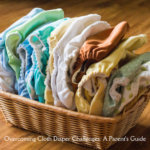For many parents, including myself as a dad of three young children, cloth diapering is a valuable practice that aligns with eco-friendly parenting goals. However, dealing with leaks can be frustrating. In this comprehensive guide, I’ll share practical tips and insights to help you prevent leaks in your cloth diapering journey, ensuring comfort for your baby and peace of mind for you.
Managing Cloth Diaper Leaks
Understanding the Causes of Cloth Diaper Leaks
Fit and Size Issues
- Improper Fit: A diaper that is too loose or too tight can lead to leaks. Ensuring a snug fit around the waist and legs is crucial.
- Size Adjustments: As babies grow, their diaper size needs adjustment. Regularly assess the diaper’s fit as your child develops.
Absorbency Challenges
- Material Matters: The type of fabric can affect absorbency. Materials like hemp and bamboo are more absorbent than microfiber.
- Layering Up: Sometimes, the diaper itself isn’t absorbent enough for your child’s output. Adding boosters or liners can enhance absorbency.
Tips for Ensuring a Proper Fit
Check the Waist and Leg Elastic
- Gap Test: Ensure no gaps exist around the legs and waist. There should be enough space to slide one finger under the elastic comfortably.
- Waist Snugness: The diaper should be snug but not pinching. Adjust the waist snaps or Velcro for a better fit.
Adjust the Rise Settings
- Snap Adjustments: Many cloth diapers come with adjustable snaps that allow you to change the diaper’s size as your baby grows. Ensure these are set to match your baby’s current size and shape.
Maximizing Absorbency
Choose the Right Insert
- Material Types: Prefold diapers, flats, and inserts made of natural fibers like cotton, bamboo, or hemp offer superior absorbency over synthetics.
- Doubling Up: For heavy wetters, particularly at night, consider doubling inserts or using a combination of materials.
Prepping New Diapers
- Initial Washes: New cloth diapers made from natural fibers need to be washed multiple times before use to strip natural oils and enhance absorbency.
Leak-Proofing Strategies
Use Diaper Covers
- Cover Types: For extra protection, especially at night, use a PUL (polyurethane laminate) or wool diaper cover over your fitted diapers or prefolds.
Optimize Washing Routine
- Clean Routinely: Build-up of detergent or fabric softener can affect the absorbency of cloth diapers. Use a proper amount of a cloth-diaper-friendly detergent and perform occasional strip washes to remove residue.
Real-Life Application: A Dad’s Experience
Routine Adjustments
- Fast Response: Change diapers frequently to avoid over-saturation, especially after meals or before bedtime.
- Tailored Solutions: Not all solutions work for every child; it took trial and error to find the right combination of fit and absorbency for each of my kids.
Advanced Tips for Troubleshooting
Addressing Compression Leaks
- Movement and Pressure: If leaks occur when your baby is in a carrier or car seat, consider adjusting the tightness and absorbency around the pressure points.
Nighttime Solutions
- Overnight Diapers: Use specific nighttime solutions like extra-absorbent fitted diapers or special overnight inserts to handle prolonged periods.
Mastering Leak Prevention in Cloth Diapering
Stopping leaks in cloth diapers often involves a combination of adjusting fit, boosting absorbency, and maintaining your diapers correctly. With these strategies, you can enjoy the benefits of cloth diapering without frequent leaks disrupting your day or night.
As you refine your approach, remember that each child’s needs may differ, and what works at one stage might need adjustment as they grow. Embrace the journey of cloth diapering with confidence, knowing that each challenge offers an opportunity to learn and adapt for the betterment of your child’s comfort and well-being.
For more detailed tips, tricks, and product recommendations on cloth diapering, visit our dedicated parenting resource at ParentingChic.com.







